Kite Surfing Adventures in South Carolina
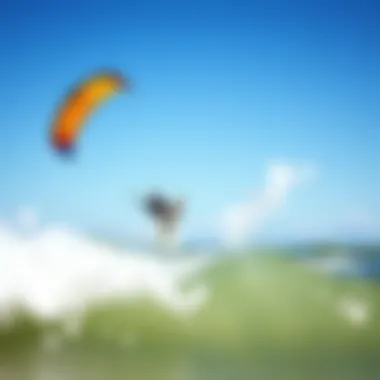
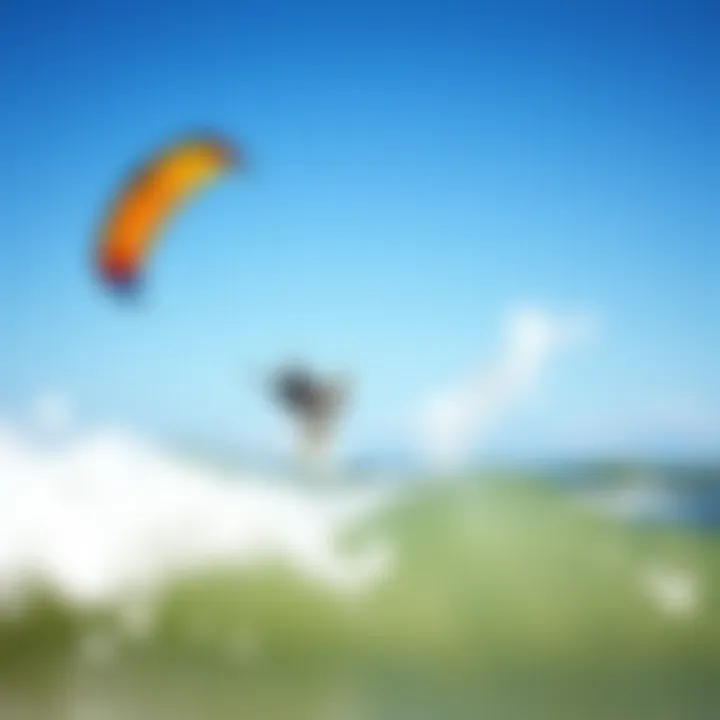
Intro
Kite surfing, a sport that fuses the thrill of surfing with the excitement of flying, has gained a significant following along the sandy stretches of South Carolina. From the breezy shores of Folly Beach to the expansive waters of the Outer Banks, kite surfing draws in both seasoned pros and eager beginners. If you’re looking to ride the waves while harnessing the power of wind, then South Carolina is a playground waiting to be explored.
Whether you're an individual who can’t get enough of the ocean or someone drawn by the enveloping community, there is much to learn. This guide aims to provide not just the practical aspects of kite surfing – such as key locations, essential gear, and safety protocols – but also dives into the culture that surrounds it. Like a well-tied knot on your kite lines, each section serves as a connection, aiming to hold together the elements that make kite surfing in this region both unique and accessible.
Gear Selection
When diving into kite surfing, selecting the proper gear can feel like trying to find a needle in a haystack. With a variety of options available, it’s crucial to understand what each piece does and how it contributes to your overall experience on the water.
Types of Kites
Choosing the right kite is fundamental. Kites come in various shapes and sizes, each designed for specific wind conditions and skill levels. Here are a few popular options:
- Foil Kites: These are known for their light weight and efficiency, often used in low-wind conditions.
- C-Kites: Shaped like a ‘C’, these kites are best for freestyle actions and are favored by advanced riders.
- Delta Kites: With their brilliant design, Delta kites are versatile and perfect for both beginners and intermediates, handling a wide range of conditions.
Knowing the winds where you plan to surf can also help narrow down your choice. A day with steady winds may call for a different kite than when gusts are in play.
Choosing the Right Board
Next in line is the board, which can be the difference between a smooth ride and handling a bucking bronco. Here are key types you might consider:
- Twin-Tip Boards: Ideal for those starting out, these boards let you ride in both directions, facilitating quick learning.
- Directional Boards: More suited for experienced riders, these resemble traditional surfboards and require more skill to maneuver.
- Surfboards: Perfect for big waves, surfboards can be used in the ocean and provide a different type of experience from twin-tip boards.
When choosing a board, factors such as size and material play a significant role. You want something that provides good control and stability, especially as you're getting used to varying water conditions.
Skill Development
Once you've got your gear, the next step is sharpening those skills.
Essential Techniques
Understanding core techniques is vital for progress. Here are some foundational moves:
- Body Dragging: A useful technique for retrieving your board after a fall. Practice makes perfect!
- Water Start: This is where you’ll finally get on that board; mastering this will set you on your way to gliding seamlessy over the waves.
- Kite Control: Learning how to steer the kite effectively impacts your speed and overall control.
Progression Tips
As you build confidence, try these tips:
- Set Small Goals: Aim for specific skills each session rather than overwhelming yourself with the big picture.
- Join Local Communities: Connecting with others can accelerate learning. The camaraderie often found on the beaches adds another layer of enjoyment.
- Take Lessons: If self-teaching proves tedious, consider getting lessons from certified instructors who can provide valuable insights.
As you make progress, remember that kite surfing is as much about enjoying the ride as it is about the skills you learn along the way. South Carolina’s wind and waves call for an unforgettable journey, so gear up, sign on, and step into the experience.
“The ocean stirs the heart, inspires the imagination, and brings eternal joy to the soul.” – Wyland
For more resources on kite surfing in South Carolina check out Wikipedia or engage with local communities on Reddit.
Kite surfing isn't just a sport; it's a way to bond with nature and with those who revel in its beauty. As you navigate your path in this exhilarating world, keep your kite high and your spirit higher.
Intro to Kite Surfing
Kite surfing is not just a sport; it’s an experience that combines the thrill of gliding over water with the mastery of wind. The essence of this activity transcends mere recreation, weaving into the fabric of coastal culture and inviting both the adventurous and the contemplative. Understanding kite surfing provides crucial insights for anyone looking to partake in this dynamic pursuit, whether as a novice or as an experienced enthusiast.
Defining Kite Surfing
At its core, kite surfing involves harnessing the wind to propel oneself across water on a board. This sport utilizes a large, steerable kite to catch the wind while the rider stands on a board beneath. The interactions between kite, wind, and water create exhilarating movements, offering a unique blend of balance and skill. The equipment largely consists of the kite, the board, and a harness, all of which work in concert to deliver the rider across the waves.
Kite surfing encompasses various styles, from freestyle maneuvers that focus on tricks and jumps to wave riding which emphasizes fluidity and style against ocean swells. Depending on conditions, kite sailors can engage in light sea breezes or stronger gusts, showcasing an adaptability that keeps the sport fresh. Mastering kite surfing comes with significant practice, and beginners often find themselves drawn into a community that thrives on shared passion and knowledge.
The Rise of the Sport
Kite surfing has soared in popularity over the last two decades, evolving from a niche activity into a mainstream sport embraced globally. Its rise can be attributed to several factors:
- Technological Advancements: Improved design of kites and boards, making equipment safer and more accessible.
- Media Influence: Videos and social media showcasing daring stunts and breathtaking scenery inspire a new generation of kite surfers.
In the early days, kite surfing appeared like an eccentric cousin to windsurfing. Now, it stands tall on its own, with competitions attracting world-class talents and a dedicated following around the globe. Local clubs and communities have spring up, offering lessons and events that foster camaraderie.
As those who kite surf can attest, it’s not just a physical activity but a lifestyle choice, pulling individuals into nature and away from their daily grind. The allure of catching the wind and dancing on the waves has solidified kite surfing as more than a fad; it is a lasting testament to the spirit of adventure.
"Kite surfing isn’t just about the ride; it’s the journey of mastering the elements that truly captivates the soul."
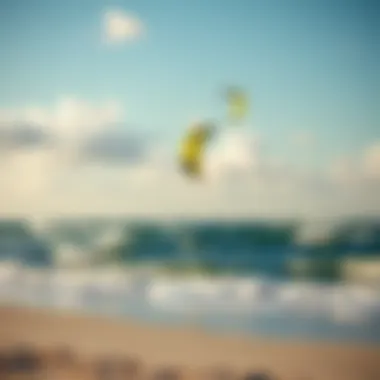
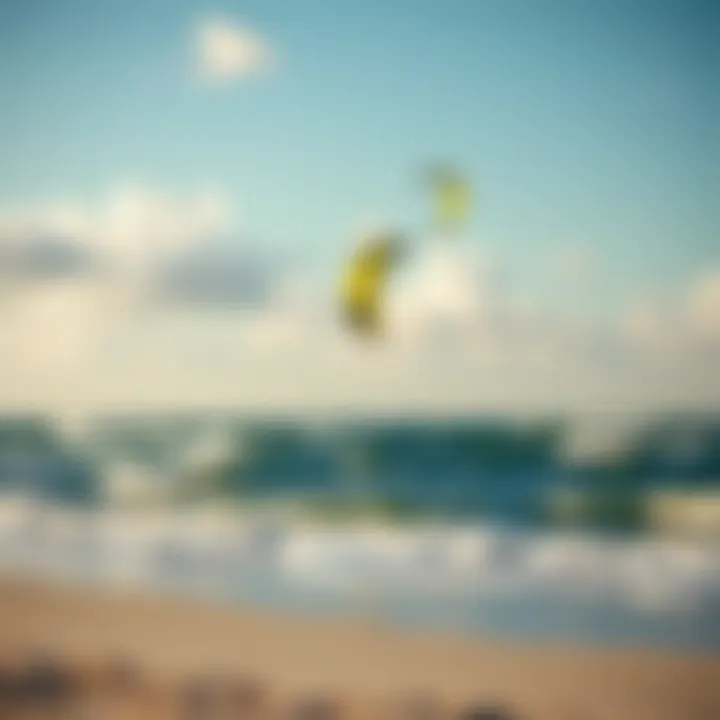
The blend of thrill and freedom makes kite surfing a worthy pursuit, echoing loudly along the breezy shores of South Carolina where the sport has become increasingly prominent. Whether embarking on your first session or refining your skills, understanding the significance of kite surfing's rise will enhance your appreciation for this captivating sport.
Kite Surfing in South Carolina
Kite surfing in South Carolina has steadily become a talk of the town among water sports enthusiasts. It weaves together the excitement of surfing, the thrill of flying, and the relaxing vibes of the coast. From novice to pro kite surfers, there’s a wave for everyone in this region. The geographical benefits and weather characteristics make South Carolina a pretty desirable choice for kite surfing. Add to this the strong community and culture surrounding the sport, and it becomes clear why this topic is worth diving into.
Geography and Climate
Overview of Coastal Areas
The coastal areas of South Carolina shine with golden beaches and vibrant ecosystems. Places like Folly Beach and Kiawah Island stand as prime locations, offering a blend of breathtaking landscapes and suited conditions for kite surfers. These areas are not only aesthetically appealing but also provide ample space to soar. One significant aspect is that the waters remain relatively shallow near the shore, which is a great safety feature for novice kite surfers.
When the North Atlantic winds sweep through, these locations become playgrounds for both leisure seekers and serious kite surfing aficionados. However, being crowded on weekends can sometimes be a disadvantage. Surfers need to be mindful about their space and the safety of others.
Wind Patterns and Seasonal Changes
Wind patterns in South Carolina are a kite surfer's best friend. Generally, the best wind conditions occur in the late spring and early fall, which is vital for riders looking for ideal kite surfing weather. During this time, north-easterly winds stack up, creating consistent breezes that help lift the kites high into the sky.
Nevertheless, it’s important to remember that wind can be capricious. A sudden shift can change a pleasant day into a risky venture! So knowing when the winds are cooperating is crucial. The blend of favorable wind conditions and a picturesque backdrop enables kite surfers to enjoy more than just the sport—it’s about soaking up nature’s beauty as well.
Popular Locations for Kite Surfing
Kite Surfing in Charleston
Charleston is a dynamic hub for kite surfing. The city has an active community and a rich historical backdrop, making it appealing to both tourists and local surfers. The consistent winds provide conditions that cater to different skill levels, which is another factor contributing to its popularity. Add the scenic view of the historic seaside, and you’ve got a perfect spot.
However, Charleston can sometimes be a bit busy, especially during peak times. Surfers might find themselves waiting for the right conditions signal, but the experience and camaraderie often make up for it!
Kite Surfing in Myrtle Beach
Myrtle Beach presents a more bustling atmosphere, with its family-friendly vibe complementing the kite surfing scene. The broad sandy beaches allow for plenty of room, and the strong winds ensure that kite surfers can enjoy a few jumps and tricks. Furthermore, the locals are generally welcoming, and events organized here encourage both beginners and veterans to mingle.
On the downside, the vibrant tourism can turn the beach crowded, making it difficult at times to find your space to ride. Still, the energy of the crowd often pumps life into the experience.
Less Known Gems
Not all treasures are well advertised, and this holds true for sites lesser known in South Carolina. Areas like Huntington Beach State Park and Edisto Beach might not draw big crowds, but they’re perfect for those seeking a quieter experience. These spots provide a more laid-back atmosphere where surfers can connect with nature and focus on their technique.
Each has its own unique features, such as pristine views and less tourist traffic, making them hidden gems for keen kite surfers. However, accessing some of these locales may require a bit of a trek, as amenities might be limited.
"Exploring lesser-known places can lead to surprising discoveries in the kite surfing community."
With all these options available, kite surfing in South Carolina emerges not just as a sport but as a lifestyle. The combination of geography, community, and a shared passion enhances the experience, attracting people to the shores and fueling the growth of this exhilarating sport.
Essential Gear for Kite Surfing
The gear you choose plays a crucial role in your kite surfing experience. Having the right equipment not only enhances your performance but also ensures your safety while navigating the waters. Kite surfing in South Carolina's varied conditions requires a specific set of tools, designed to match the environment and your skill level. Thus, understanding the intricacies of essential gear can greatly impact your enjoyment of the sport.
Choosing the Right Kite
When it comes to kite surfing, the kite itself is often seen as the heart of the sport. This decision can influence everything from your control on the water to your overall experience.
Types of Kites
Kites are mainly divided into two common types: LEI (Leading Edge Inflatable) and Foil Kites. LEIs feature a rigid structure made of inflatable tubes, providing excellent stability and control. These are suitable for various wind conditions, making them a popular choice for most kite surfers. Conversely, foil kites rely on fabric cells to capture air. They are lightweight and perform incredibly well in low winds, often preferred by advanced kiters seeking high speeds.
The unique advantage of LEI kites is their durability and ease of relaunching from the water, which is critical for beginners in places like Myrtle Beach or Charleston. In South Carolina, where wind conditions can shift, choosing a kite that matches both your skills and the local conditions, can lead to a much smoother ride.
Size Considerations
Size is a pivotal aspect when selecting a kite. Generally, larger kites catch more wind and provide more power, making them ideal for lighter wind conditions. However, they also require more skill to manage and can feel cumbersome in stronger winds. Smaller kites, on the other hand, are easier to handle and are often the go-to for high-wind days, but they deliver less power.
For South Carolina's dynamic coastal environment, knowing your body weight and the wind range you’ll be riding in helps to pin down the appropriate size kite. Being overly ambitious with a large kite in strong winds can lead to issues, while a too-small kite in light breezes might not provide enough lift.
Boards and Accessories
Like kites, boards are essential to your kite surfing kit, as they directly affect performance and comfort. Choosing the right board is as important as selecting your kite.
Types of Boards
There are a few common types of boards used in kite surfing: Twintip Boards, Directional Boards, and Foil Boards. Twintip boards are the most versatile, allowing riders to go both ways without needing to switch the board around. This makes them an excellent choice for beginners. Directional boards are typically used in waves, designed specifically for those looking to carve through the surf. Foil boards open up an entirely new experience, allowing riders to glide above the water, reducing drag dramatically.
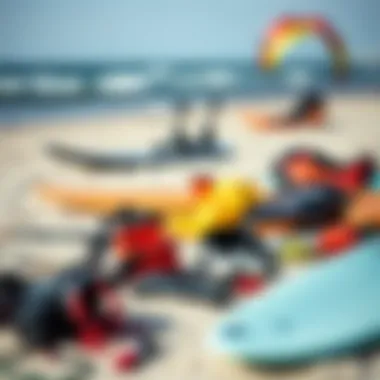
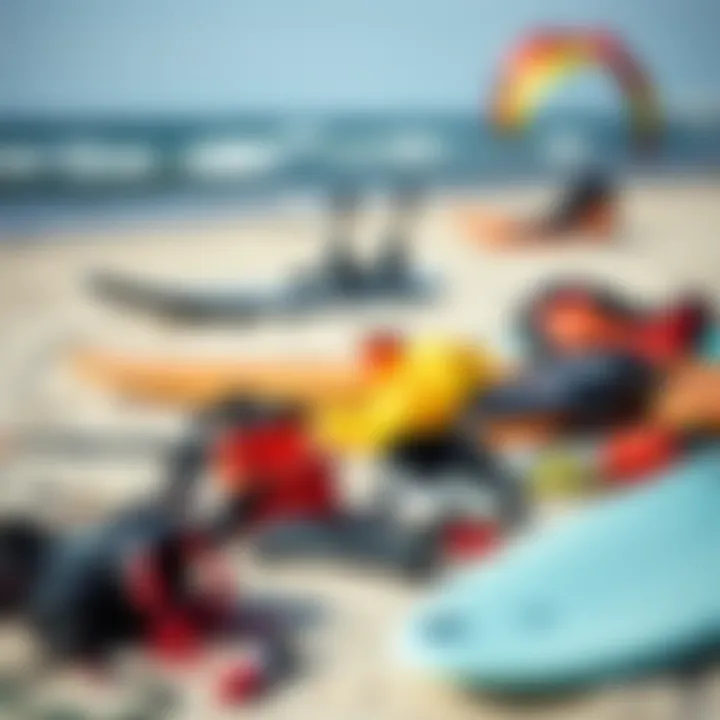
In South Carolina, the most popular choice tends to be the twintip board due to its adaptability for the variable conditions. Riders can easily learn tricks and transitions, making the most of the coastal landscapes.
Safety Equipment
Moreover, safety equipment cannot be overlooked. Items such as helmets, impact vests, and leashes are crucial for reducing risks while riding. The right safety gear can protect against harmful impacts and even improve your confidence while learning new maneuvers.
For instance, a helmet guards against sudden falls while a leash ensures you don’t lose your gear during gusty winds or wipeouts. These small yet significant investments in safety gear can save you from serious injury, allowing you to enjoy the thrills without unnecessary risks.
"Safety first; this ensures that you can focus on the fun, not the fear."
South Carolina’s local kiting community often stresses the necessity of investing in durable, high-quality safety gear that is appropriate for the conditions.
With an understanding of selecting the right type of kite and board along with necessary safety equipment, you can elevate your kite surfing experience immensely. Each choice you make, from kite type to accessories, contributes to not just how you perform, but to the overall adventure of riding those coastal winds.
Skill Development
In kite surfing, skill development is crucial—not just for enhancing one's performance but also for ensuring safety. Mastering the fundamentals can be the difference between a thrilling ride and a harrowing experience. As surfers grapple with the ever-changing conditions of wind, waves, and tides, developing strong skills allows them to navigate these challenges gracefully.
Beginner Techniques
Basic Stance and Balance
The concept of basic stance and balance serves as the very foundation for anyone eager to dive into kite surfing. To maintain equilibrium on your board, it’s essential to position your feet shoulder-width apart and keep a slight bend in your knees. This alignment provides a solid base, absorbing the bumps and jolts on the water. It’s critical, especially for beginners. Without a good stance, even the best kite will feel like a lead weight.
A key characteristic of this stance is its adaptability; whether the wind picks up or the water gets choppy, a stable stance can help you adjust quickly. Many novice kite surfers underestimate this vital point, believing they can start flying high immediately. However, taking the time to understand and practice balance can significantly affect overall performance.
The unique feature of this basic stance lies in its simplicity and effectiveness. The advantage? It lays the groundwork for more complex movements. The disadvantage? Some may find it boring at first, but investing time in mastering it pays off immensely in the long run.
Controlling the Kite
Controlling the kite is another key element for anyone serious about kite surfing. It’s like driving a car; if you don't know how the steering wheel responds, you won't get far without an accident. Understanding how to maneuver the kite’s position in the wind dramatically influences the ride. Beginners often focus on controlling the board but forget that their immediate connection with the kite is what drives the whole experience.
A crucial aspect of kite control is the ability to read wind conditions. Wind speed and direction are not constants; they fluctuate, and experienced kite surfers earn their stripes by adapting quickly to these changes. Thus, honing this skill becomes advantageous because it not only enhances maneuverability but also keeps the surfer safe from potential accidents.
This control’s unique feature is the immediate responsiveness it offers the rider; a slight shift in hand position can change everything from speed to height off the waves. The disadvantage? Control requires practice and patience to refine skills over time, which can be frustrating for some individuals.
Advanced Maneuvers
Jumping and Tricks
Once a kite surfer has the basics down, jumping and tricks become the next thrilling step. Mastering these maneuvers opens up a world of creativity and personal expression on the water. The fundamental nature of jumping revolves around the ability to harness the kite’s power at the right moment, enabling the rider to take off with style.
The key characteristic of jumping is timing—the surfer must gauge the impulse of the wave while simultaneously controlling the kite. This not only creates an exhilarating feeling of flight but also adds dynamics to the overall performance. Unlike beginners, who often ride the board, advanced surfers start to use the kite's lift intentionally, making jumps one of the most enjoyable aspects of kite surfing.
The unique feature here is the element of risk versus reward. The advantage of jumping can lead to thrilling experiences, while the associated risk—such as misjudging height or landing improperly—can lead to injuries. Advanced kite surfers need to commit to continuous practice to navigate these challenges effectively.
Dealing with Changing Conditions
Navigating changing conditions is a skill that every kite surfer must develop. In South Carolina, the weather can shift unexpectedly, making the ability to adapt paramount for both fun and safety. This skill encompasses everything from adjusting kite size according to wind changes to selecting appropriate spots based on current conditions.
The key characteristic of dealing with changing conditions lies in awareness. Experienced kite surfers possess an innate ability to assess their surroundings and adjust as necessary, ensuring a safer ride. As conditions shift—like switching from light winds to gusts—those who can effectively respond will enjoy a more rewarding experience.
The unique feature of this skill is its reliance on experience and intuition, much more than technical know-how. The advantage is clear; solid adaptation skills allow the surfer to take advantage of various conditions instead of being hemmed in by them. However, the disadvantage is that it can be daunting for newcomers, who might feel overwhelmed by rapidly shifting weather and conditions.
Community and Culture
Kite surfing isn’t just a pastime; it’s a vibrant community that transcends geographical boundaries. In South Carolina, the culture surrounding kite surfing is rich and diverse, with knowledgeable locals eager to share their insights and experiences. It’s critical to recognize that being part of this community enhances not only the sport itself but also the very experience of those who take to the waves.
Local Clubs and Organizations
Local clubs play a pivotal role in promoting kite surfing and fostering camaraderie among enthusiasts. Organizations such as the Carolina Kite Club offer a platform for members to connect, learn, and share their passion. Being involved in such groups oftentimes means access to workshops, meet-ups, and even mentorship opportunities, allowing newcomers to gain vital skills and knowledge from seasoned kite surfers.
In addition, clubs often host social events or participate in charity functions, which helps to cultivate a supportive environment. One benefit of joining these clubs is the shared resources. For example, often they organize group purchasing of gear or offer shared equipment for club members, alleviating some financial burdens for those new to the sport.
Moreover, participating in club events is a fantastic way to network. Many experienced riders willingly share tips on gear, technique, or locations. Aligning with fellow kite surfers can not only bolster skills but also lead to lifelong friendships forged through shared waves and gusts of wind.
Events and Competitions
Events and competitions bring a unique thrill to kite surfing in South Carolina, highlighting both the skill of participants and the fun atmosphere of the surf culture. Local competitions, like the Carolina Challenge, attract kite boarders from all over, creating a platform where riders showcase their prowess, creativity, and competitive spirit. Each event serves as more than just a competition; it's a celebration of skill, friendship, and the love for the sport.
These gatherings often have a festival-like vibe, featuring vendors, music, and opportunities to try out the latest gear. They not only draw local talent but also attract visitors from nearby states, creating an influx of energy and excitement.
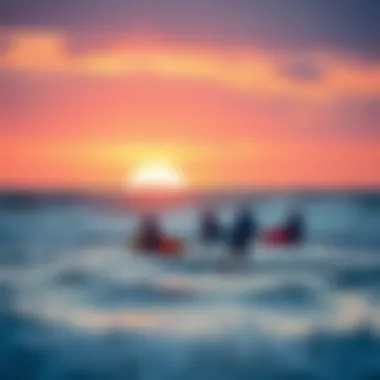
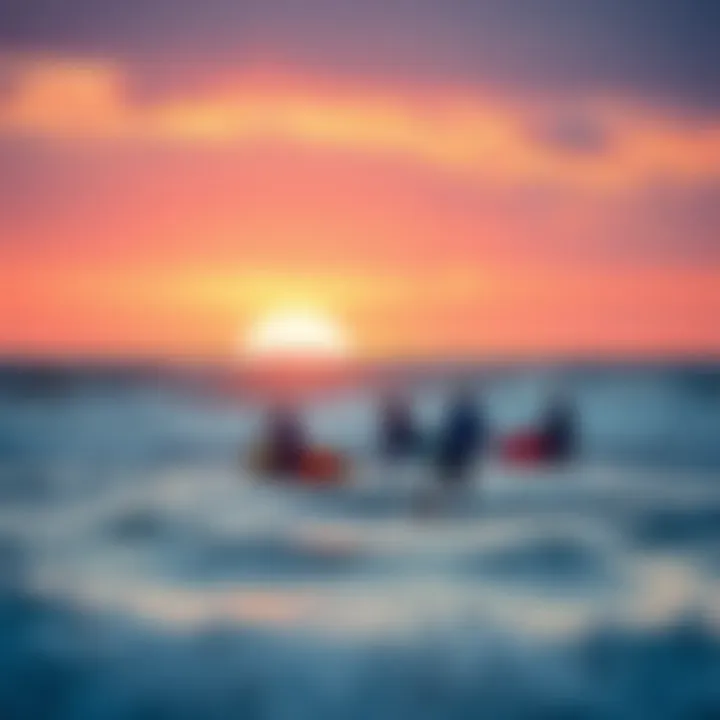
Furthermore, engaging in these events can spark inspiration. Watching skilled kite surfers perform tricks can motivate beginners to push their limits and strive for athleticism. It’s a place where everyone learns from one another, gaining valuable insights on technique and strategy under the watchful eyes of peers and competitors.
In the world of kite surfing, sharing knowledge is as crucial as the wind that fills the sails.
The End
The importance of community and culture in kite surfing, particularly in South Carolina, cannot be overstated. Local clubs and organizations foster a vibrant atmosphere for enthusiasts at every level, while competitions and events breathe new life into the sport. Together, these elements promote not only personal growth in skills but also an enriched experience, making kite surfing a truly communal journey.
Environmental Considerations
Kite surfing, while exhilarating, can have notable impacts on coastal environments. This section digs deep into why it's crucial to keep our natural areas in pristine condition and the responsibilities that come with this thrilling sport. This not only benefits enthusiasts but also sustains the very playground in which kite surfers flourish. By keeping our environment in mind, we can enjoy kite surfing while ensuring that future generations will too.
Sustaining Natural Areas
South Carolina’s beaches and waterways present a unique blend of ecosystems, from sandy shores to marshy lands. However, with the popularity of kite surfing soaring, we must act like good stewards of these natural treasures. In order to sustain these beautiful areas, it’s imperative to:
- Minimize Environmental Footprint: Stick to designated kite surfing areas to avoid damaging local flora and fauna. The wildlife that inhabits these ecosystems is sensitive and can be easily disrupted.
- Leave No Trace: Always carry out what you bring in. Broken gear, trash, and other debris can harm marine life and pollution can ruin the experience for everyone.
- Participate in Clean-Up Events: Joining local initiatives to keep beaches clean can foster a sense of community and further cement the bond between kite surfers and their environment.
To truly appreciate the beauty of kite surfing in South Carolina, you must play your part in preserving it. Adapting habits to minimize impact does not just benefit the environment but also enriches your own experience.
Responsible Kite Surfing Practices
Practicing kite surfing responsibly involves a combination of personal safety, awareness of our fellow surfers, and respect for the marine habitat. Staying vigilant about our actions can help maintain a harmonious relationship with nature. Here’s how:
- Follow Local Regulations: Different beaches have regulations concerning kite surfing. Be sure to familiarize yourself with these before hitting the waves, so your kite surfing adventure doesn't come with unintended consequences.
- Consider Wind Patterns: Not all days are ideal for the sport. Monitoring wind conditions not only ensures a safer session but also helps protect the environment. High winds can lead to injuries and affect wildlife.
- Educate Others: If you see a fellow kite surfer engaging in practices that may harm the environment, don’t shy away from a gentle reminder. Sharing knowledge promotes responsible behavior and strengthens the kite surfing community.
"The ocean stirs the heart, inspires the imagination, and brings eternal joy to the soul." - Wyland
Kite surfers, both seasoned and newbies, must remember that nature's beauty is fleeting. Adopting responsible practices ensures that the kite surfing experience remains as incredible for future riders as it is today.
Incorporating these environmental considerations into your kite surfing practice is more than just a good idea. It’s an essential part of enjoying this fantastic sport while ensuring that our natural playground remains vibrant for years to come.
Navigating Safety Protocols
When it comes to kite surfing, safety isn’t just a recommendation; it’s an absolute necessity. Navigating safety protocols is crucial for both newcomers and experienced kiteboarders. The unique blend of wind, water, and human skill makes this sport exhilarating, but it also poses dangers if proper precautions aren’t taken. By understanding and applying essential safety measures, you not only protect yourself but also foster a respectful community that prioritizes well-being.
The core aspects of navigating safety protocols involve comprehending the risks associated with kite surfing and adhering to best practices that prevent accidents and injuries.
Understanding Risks
Every adventure on the water comes with its share of risks, and kite surfing is no different. It’s paramount to recognize the potential hazards you might face:
- Weather Conditions: Strong winds and sudden weather changes can create challenging scenarios. Kite surfers should have an awareness of meteorological patterns, especially in South Carolina, where coastal weather can turn quickly.
- Equipment Failures: It’s vital to routinely check and maintain your gear. A frayed line or damaged kite could lead to unexpected mishaps. Ensuring that every piece of equipment is in top-notch condition is non-negotiable for safe sailing.
- Inexperienced Kiteboarders: Collisions can happen, especially when water is crowded. Whether you’re a seasoned pro or just dipping your toes into kite surfing, keeping an eye out for other riders is crucial. Remember, they might be figuring out their maneuvers, just like you.
Another less visible risk might involve injuries from repeated stress on the body, particularly shoulders and knees. Learning to listen to your body and knowing when to take a break is essential for sustainable involvement in the sport.
Best Practices for Safety
When kite surfing in South Carolina, implementing best practices can make all the difference. Here's a roadmap to keep your adventures safe:
- Educate Yourself: Attend local clinics or workshops led by experienced kite instructors. Learning from the local community can provide insights not just about technique but also about potential hazards specific to regional surfing spots.
- Use Safety Equipment: Always wear a helmet and impact vest. These do not just enhance your comfort but also provide essential protection against falls and unexpected crashes.
- Know the Launch and Landing Zones: Identify and respect designated areas for launching and landing your kite. This reduces the risk of collisions with other kiteboarders and swimmers.
- Communicate with Others: Use hand signals to indicate your intentions when navigating near other surfers. Communication can prevent accidents and make everyone’s experience safer.
- Kite with a Buddy: Whenever possible, kite surf with a friend. Having someone nearby can offer an extra set of eyes in case anything goes amiss.
- Respect Local Regulations: Obey all local laws and guidelines, including those surrounding environmental protection and wildlife. A responsible approach not only keeps you safe but also helps sustain the kite surfing areas we all cherish.
By absorbing and employing these safety protocols, kite surfers can ensure memorable experiences on the water. As the saying goes, "It’s better to be safe than sorry." Savoring the thrill of kite surfing should never come at the expense of your safety or the safety of others.
"Safety first, because if it’s not safe, it’s not fun."
In the bustling kiteboarding scene of South Carolina, navigating safety protocols creates not just individual security but a shared commitment to the overall well-being of the surf community. Keeping these measures in mind will encourage a healthier environment for surfers and promote enduring enjoyment of this extraordinary sport.
Closure
The conclusion of this guide on kite surfing in South Carolina serves as a vital capstone, wrapping together the threads of information presented. It emphasizes how kite surfing is not just a sport; it's a lifestyle enriched by community and nature. Understanding the various facets of this pastime helps enthusiasts—whether newbies or seasoned pros—enjoy a deeper connection with the sport and its myriad elements.
Embracing the Kite Surfing Lifestyle
Kite surfing in South Carolina offers an exhilarating blend of adrenaline and communion with the sea. But at its heart, embracing the kite surfing lifestyle means more than just mastering impressive tricks on the water. It encompasses a holistic approach, intertwining one’s passion for the sport with a respect for the environment and a commitment to the local kiteboarding community.
Engagement with Community
Interacting with fellow kite surfers can greatly enhance the experience. Joining local clubs or attending events not only sharpens your skills but also builds friendships and camaraderie that often lasts beyond the shore. Getting involved helps one understand regional quirks and preferences, plus it paves the way for mentorship opportunities.
- Local Clubs like the Charleston Kiteboarding Association provide resources for both beginners and experienced kite surfers.
- Events hosted throughout the year can range from friendly competitions to festivals celebrating the sport, instilling a sense of belonging.
Respecting Nature
Alongside community engagement, embracing this lifestyle also encompasses a commitment to preserving South Carolina's stunning coastal ecosystems. Practicing responsible kite surfing, understanding the impact on marine life, and choosing less crowded beach spots whenever possible works wonders for sustainability. Keeping local waters clean and respecting wildlife habitats should be part of every kite surfer's mentality.
"Preserve the beauty of the shores today so future generations can partake in this thrilling experience."
Personal Growth
Finally, the kite surfing lifestyle is about personal growth. Every session on the water presents learning opportunities. Whether it’s grappling with the unpredictability of wind or mastering the perfect jump, these challenges foster resilience and adaptability. The journey is as enriching as the destination, both on and off the water.
In summary, the conclusion of this guide reinforces that kite surfing in South Carolina is more than simply riding waves. It's a culture steeped in respect for nature, community, and the ongoing pursuit of self-improvement. Those who fully embrace this ethos often find themselves not just as participants, but as ambassadors for the sport, inspiring others to discover its joys.















